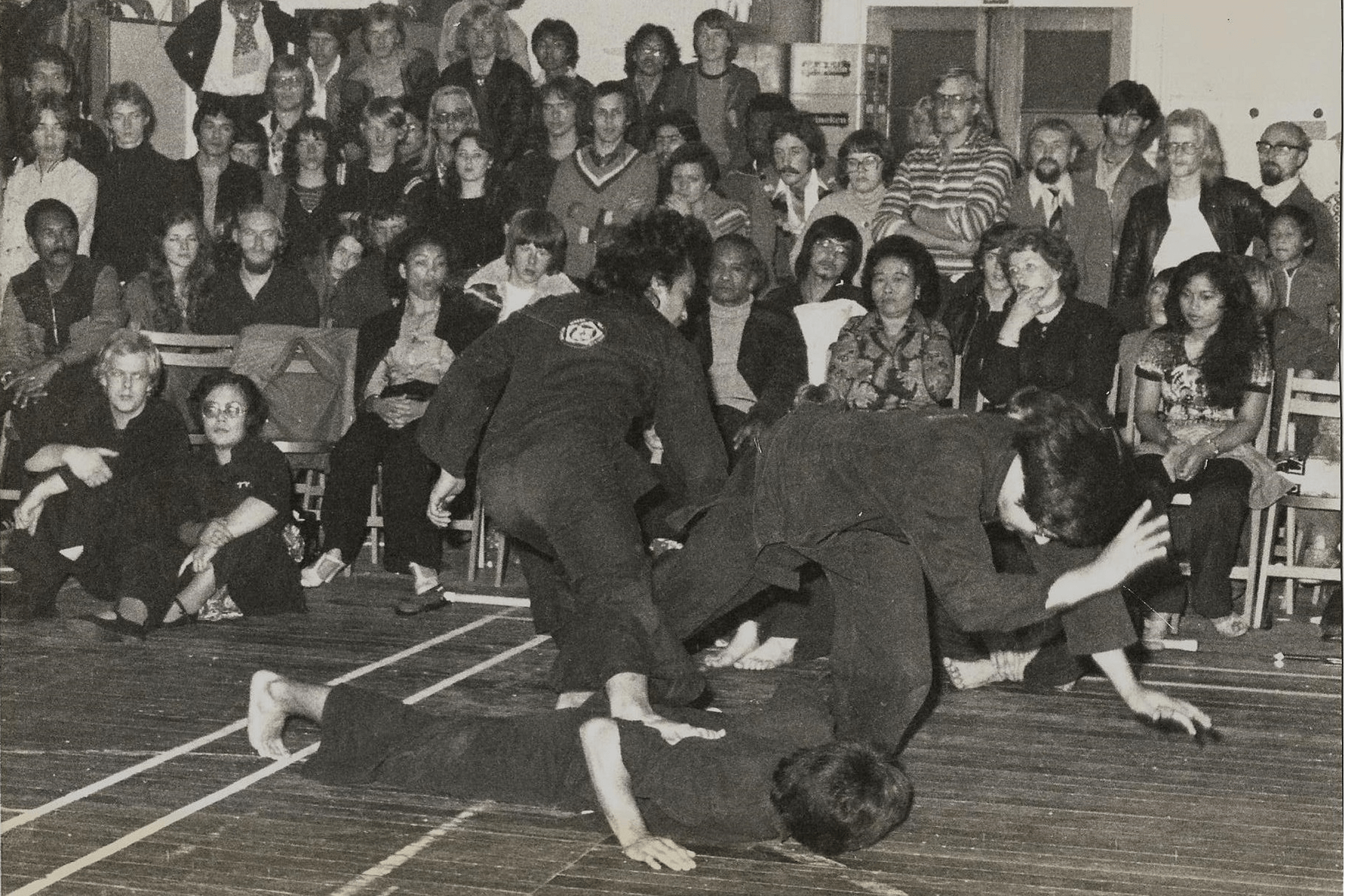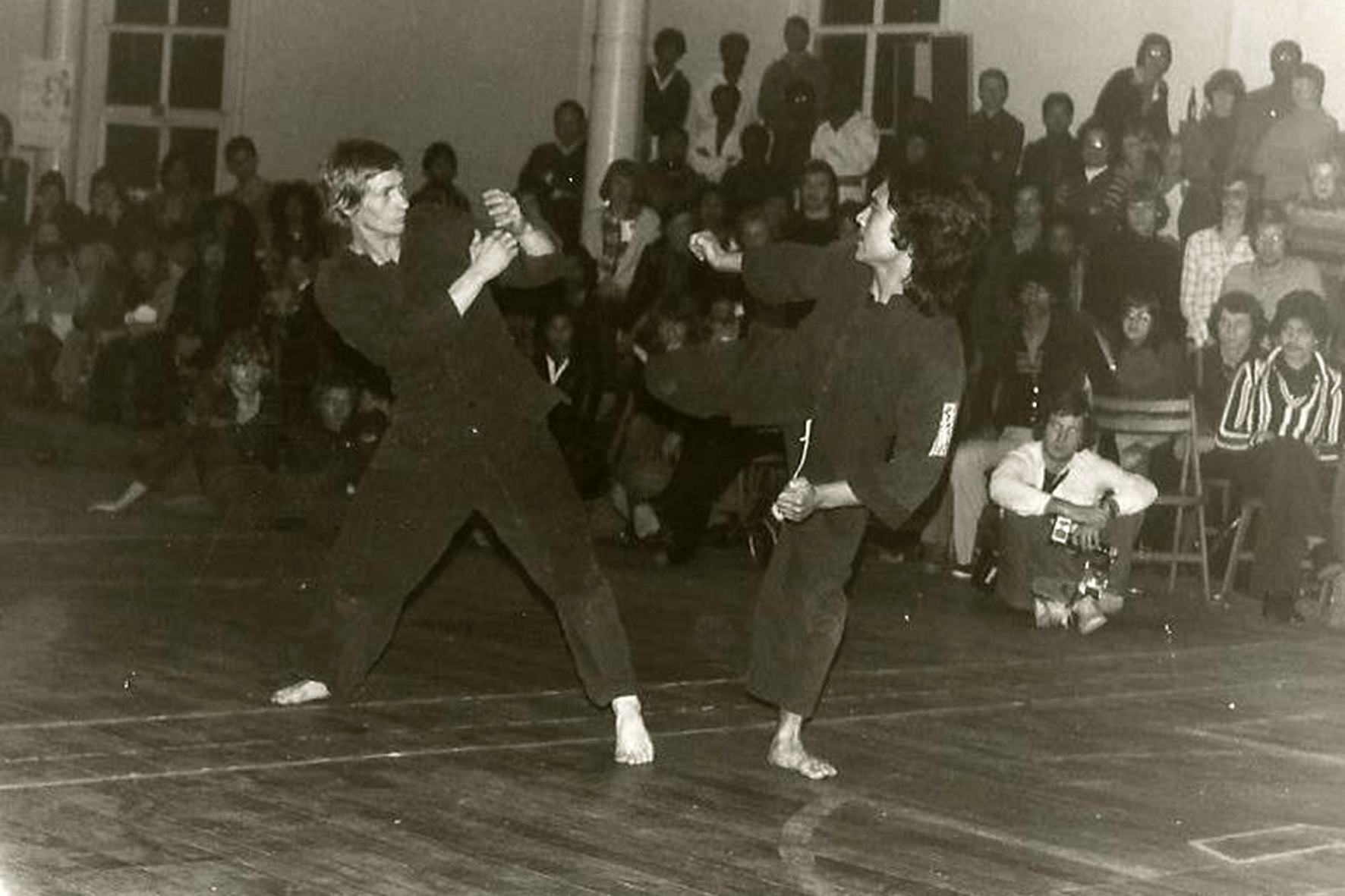
Interview Zendokan magazine, 1984
Pencak Silat. With the mentioning of these words, many "hard" martial artists will show a rather dismal smirk. "Jumping around a little", "those guys have seen too many movies, it's all bullshit, put them in a ring and there's nothing left ". And to my shame, I have to admit that I didn't have such a high opinion of the Indonesian martial art myself. Many times had I seen the demonstrations at the Indonesian evenings and Pasar Malams, and also visited a local sports center where the defensive art from the emerald belt was practiced could never change my impression of this Indonesian version of the already so popular Karate. Until I saw the Pencak Silat Bongkot of Henri de Thomis.
One of the deadliest
The deceased, world renowned authority in the area of the martial arts, Donn Draeger, devoted two books to the Indonesian martial arts and called Pencak Silat "One of the world's most deadly and efficient arts". And indeed, you can't but look on in fascination and astonishment, when two Pencak experts, with lightning speed, but at the same time grace, jet around, over and under each other. Flashing movements to the eyes, groin and throat, kicks from the most impossible positions, from crawling on the ground, to flying scissors to the neck. I can support all arguments as Pencak not being a sport, because it is much too dangerous to be one. Kepala Guru Henri de Thomis is 59 years old, and employed with the state police and has been teaching Pencak in Holland for the last 20 years. Or perhaps it is better to speak of his Pencak, the Bongkot. It is a style he himself created after long years of studying many styles of Pencak Silat.

Start learning silat
De Thomis: I started when I was about ten years old. My father was my first teacher, although his style wasn't as much Pentjak (old saying) as Pukulan (a purely reality oriented combat method, without the gracious movements of Pentjak -wr.) But he was only one of my gurus. Besides Pencak I also trained Kuntao (a martial art taught in the Chinese communities of Indonesia, comparable to what we know as Kung Fu -wr.), and thus underwent many influences. We trained on a small attic or totally outdoors. I still remember the saturday evenings, it was warm, sticky and you could hear the drums beating. You only needed to follow the sound and you naturally ended up in the training place. I myself trained 3 times a week and in the weekends went to train with other teachers, which in those days wasn't easy, because of the closed character of the art. Every style was different and was kept a closely guarded secret. In those days I practiced Serak, a form of Pukulan. Later I practiced Cimande and when I came to East- Java, Dero Somo (D'ro S'omo). I was insatiable, again and again I wanted to study new styles, find different Gurus and in this way gather knowledge of Pencak. At a certain moment I was unstoppable.
Ready for competition
In 1959 de Thomis came to Holland and here too, he expanded his knowledge of the martial arts. Finally, he ended up at sportschool Bregonje in Groningen and aquanted himself with Kyokushinkai Karate. His exposure to this hard karate style would later be of great influence in his development of the concept of letting Pencak practitioners have the opportunity to enter "normal" martial arts events. Especially his son Raoul made furore at the national karate shiaos and easily maintained himself at the national selections of '74-'75. De Thomis: It especially irked my sons that Pentjak was thought so lowly of. Although I myself didn't care that much, they were eager to proof to any who would listen that they could do more than "dancing". Of course, Pencak isn't a contest sport, but to give the youth an outlet for their competitive urges I let them take part in games. Better that they proof themselves there than anywhere else. De Thomis: Pencak is a play which has many low stances, which is hard and destructive, and which really has to only be used as an emergency break.
The hard way
By letting them participate in Karate and All Style games, they learn to fight on all levels. Look, what they show in those matches is only 30% of all techniques, but you know, the outlet is very important. Let them enjoy themselves there. I always say, you're not accountable for what you think, but you are for what you do, and I hope I never have to pull that emergency break called Pencak Silat. The Guru certainly isn't soft on his students. As gentle as he teaches children, so hard is he on his older students and assistants. De Thomis: Life is hard, my life has been hard. The experience you gain here, you take into society, and there you have to be able to be hard on yourself as well; I want my students to become strong and balanced people and if that means that I have to be hard on them, I certainly won't hesitate to do so.
Stories to tell
Legion are the stories which go around of superhuman powers of old gurus and although Henri de Thomis is a sober man of practice, he won't just wave them all aside. About his own experiences with inexplicable demonstrations of old Pencak masters de Thomis is remarkably silent. What he does do is point out some peculiarities, such as when he first had to perform some menial chores for a guru, before being taken in as a student. Or he had to clean the garden and when he finally gathered all the leaves in a basket, the guru came and tipped it over. All this to test him. De Thomis: Of course, I also heard the stories of gurus who could kill at a distance and such. I've also seen some strange things which can't be explained away easily, but none were more or less remarkable than the achievements of the fakirs of India, and those are slowly being accepted as true. I am a man of practice, I have consciously experienced the spiritual aspect, but it never had a special attraction for me. And all those stories, well, there's a kernel of truth in every myth or legend, but people have a knack of exaggerating.
Pioneering Pencak Silat
When we're talking about practice, then we’re getting closer to the Bongkot, his own style of Pencak Silat. Really, it is more of a collection of the many Pencak styles which were studied by him and Kuntao, with an emphasis on combat value. Proudly, he shows a photograph of some years ago with him and a representative of the Indonesian embassy and the chairman of the Indonesian Pencak Silat Federation, during the official recognition of the style created by him. The style, which name is Bongkot (root, or trunk), received its name from the same chairman, Bapak Djunaidi, and this is something for which Henri de Thomis still owes him a debt of gratitude. Meanwhile, the pioneering work of Henri de Thomis has resulted in the creation of a ministerially recognized Pencak Union in Holland and in this way it is attempted to regulate Pencak in a responsible manner. De Thomis: I think 2000 people are affiliated but that's only half of all practitioners in Holland. Of course, everyone who wants to can become a member, although they have to allow comprehensive study beforehand. If they want to join us, certain standards must be met, which I think is reasonable. If they won't or can't, that’s fine too.
Words are better than fists
Everyone in his own way has a love for Pencak Silat, only we're enforcing certain norms. This doesn't mean that other's norms aren't good, just that they don't fit into the concept which we have thought out in collaboration with the mother Union, the IPSI (Ikatan Pencak Silat Indonesia), that's all. For 49 years, Pencak Silat has ruled the life of this dynamic man, who, besides the serious side of teaching, goes through life with a large sense of humor ("It isn't the style, it's the man which does it, but only I think my style is the best, - laughing- "), a Pencak which he cherishes and loves and wants to protect against misuse at all costs ("My greatest concern is inappropriate use" and "I don't want to use my knowledge, you see, my condition isn't that good anymore, so if they would force me, I would have to finish the job and I don't want that, words are better than fists.")
Unsigned, Zendokan, feb. 1984